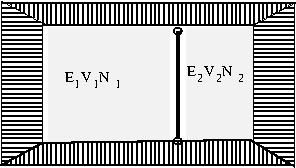Category:
Using the principle of maximum entropy, we derive conditions so that an isolated system consisting of two systems may be in equilibrium.
$\newcommand{\Label}[1]{\label{#1}}\newcommand{\pp}[2][]{\frac{\partial #1}{\partial #2}}\newcommand{\dd}[2][]{\frac{d #1}{d#2}}$
In this section we will derive equilibrium conditions for an isolated system consisting of two systems in contact. Three cases will be important.
Case-I : \(V_1,V_2, N_1,N_2\) held fixed
The two systems specified by \(E_1,V_1, N_1\) and \(E_2, V_2, N_2\) are separated by a diathermal wall which allows exchange of energy only. The wall is opaque and does not allow exchange of particles and is held fixed. Thus the volumes \(V_1, V_2\) remain unchanged.
 |
| Two systems separated by a diathermal wall |
We use the Clausius statement that in the equilibrium the entropy of an isolated system is maximum. In this case the total energy, volume and number of particles remains constant because the system is isolated. So
\begin{eqnarray}\Label{EQ01}
E &=& E_1+E_2\\ \Label{EQ02} V &=& V_1+V_2\\\Label{EQ03}
E &=& N_1+N_2
\end{eqnarray}
In the present case, during the time the system evolves and comes to an equilibrium only the energies \(E_1, E_2\) will change
with total energy \(E\) remaining constant. The total entropy \(S\) will be taken as a function of independent quantities \(E, E_1, N, V\) and will be a sum of the entropies of the two systems.
\begin{equation}\Label{EQ04}
S(E, E_1, V,N) = S_1(E_1, V_1, N_1) + S_2(E_2, V_2, N_2).
\end{equation}
Computing the derivative w.r.t. \(E_1\) and equating it to zero, we get
\begin{equation}\Label{EQ05}
\left(\pp[S]{E_1}\right)_{E,V.N, V_1, N_1} = \left(\pp[S_1]{E_1}\right)_{V_1,N_1} + \left(\pp[S_2]{E_1}\right)_{V_2,N_2} \dd[E_2]{E_1} =0.
\end{equation}
Using \(E_2=E-E_1\), we get
\begin{equation}\Label{EQ06}
\left(\pp[S_1]{E_1}\right)_{V_1,N_1} - \left(\pp[S_2]{E_2}\right)_{V_2,N_2}=0.
\end{equation}
This equation gives the condition of thermal equilibrium that no heat transfer takes place between the two systems. This relation must imply that in thermal equilibrium the temperatures of the two systems are equal. In general each side can be a function of absolute temperature \(T_1\) and \(T_2\).
In fact using known results from thermodynamics we can write
\begin{equation}\Label{EQ07}
\left(\pp[S_k]{E_k}\right)_{V_k,N_k} = \frac{1}{T_k}, \qquad k=1,2.
\end{equation}
The equilibrium condition \eqRef{EQ06} implies equality of temperatures, \(T_1=T_2\).
Case-II : Only \(N_1;N_2\) are held fixed
In this case we assume that the two systems as before and that the wall separating them is movable, allows heat transfer but the exchange of particles is not allowed. In this case \(E_1,E_2, V_1, V_2\) will change but \(N_1, N_2\) will remain fixed.
 |
| The partition is a movable diathermal wall |
We need to maximize the expression \eqref{EQ04} w.r.t. \(E_1, V_1\) keeping \(E_2=E-E_1\) and \(V_2=V-V_1\). In addition to \eqref{Eq06}, we get one more condition \begin{equation} \left(\pp[S_1]{V_1}\right)_{E_1,N_1} - \left(\pp[S_2]{V_2}\right)_{E_2,N_2}=0. \end{equation}
The two terms of the above equation give the pressures of the two systems. \begin{equation}\label{EQ07A} P_k = T_k \left(\pp[S_k]{V_k}\right)_{E_k,N_k} \qquad k=1,2. \end{equation} and the equilibrium conditions are \(T_1=T_2\) and \(P_1=P_2\).
Case-III: All \(E_1,E_2, V_1,V_2, N_1, N_2\) are variable
Now we assume that the partition is a permeable membrane that allows particles to cross over. In addition, as before we take the partition to be diathermal and movable
 |
| The partition is a movable, diathermal and permeable wall |
In this case all the three variable \(E_1, V_1, N_1\) will change and equilibrium will be attained when the entropy is maximum. proceeding as before, we get a new relation \begin{equation} \left(\pp[S_1]{N_1}\right)_{E_1,V_1} - \left(\pp[S_2]{N_2}\right)_{E_2,V_2}=0. \end{equation} This requirement leads us to introduce the chemical potential of the systems by means of the equation \begin{equation}\label{EQ09} \mu_k =- T_k \left(\pp[S_k]{V_k}\right)_{E_k,N_k} \qquad k=1,2. \end{equation} In the equilibrium the chemical potentials of the two systems must be equal.
| REMEMBER |
|






 ||Message]
||Message]
